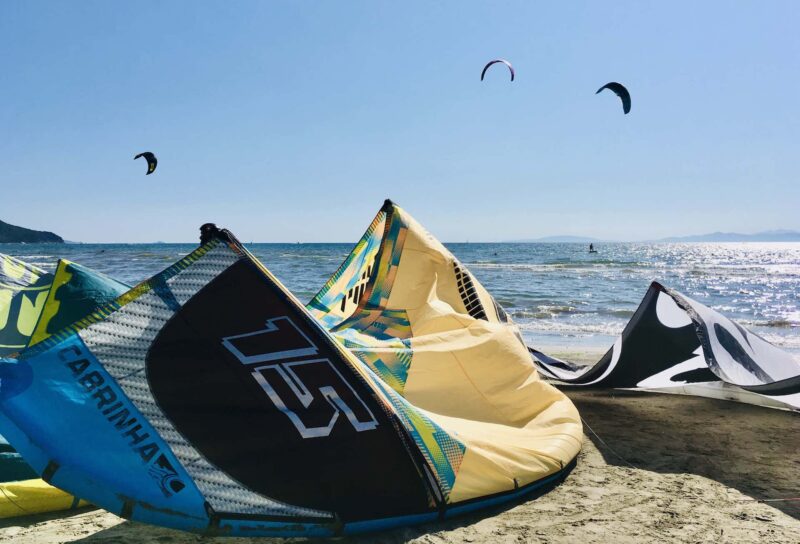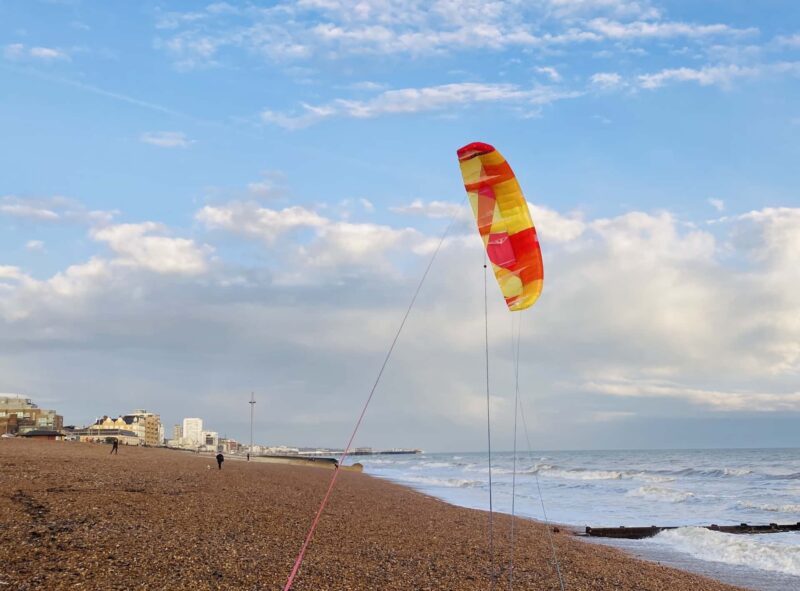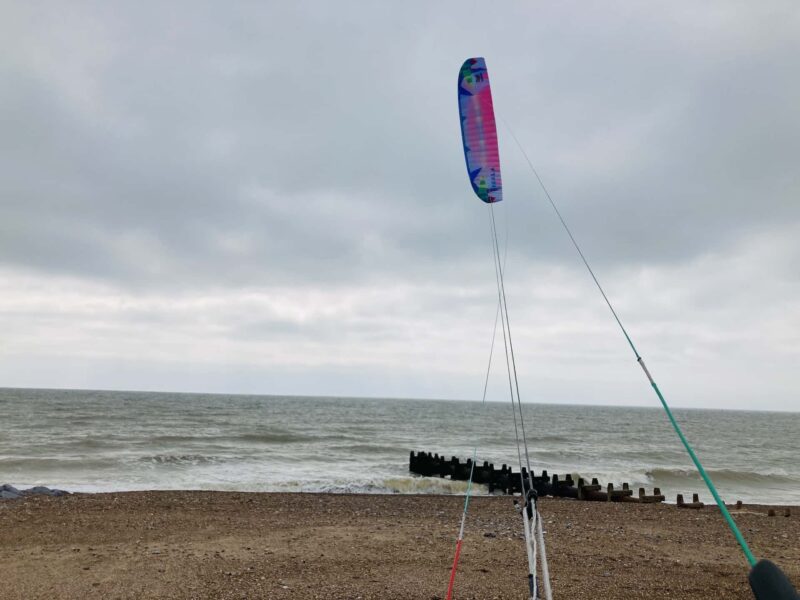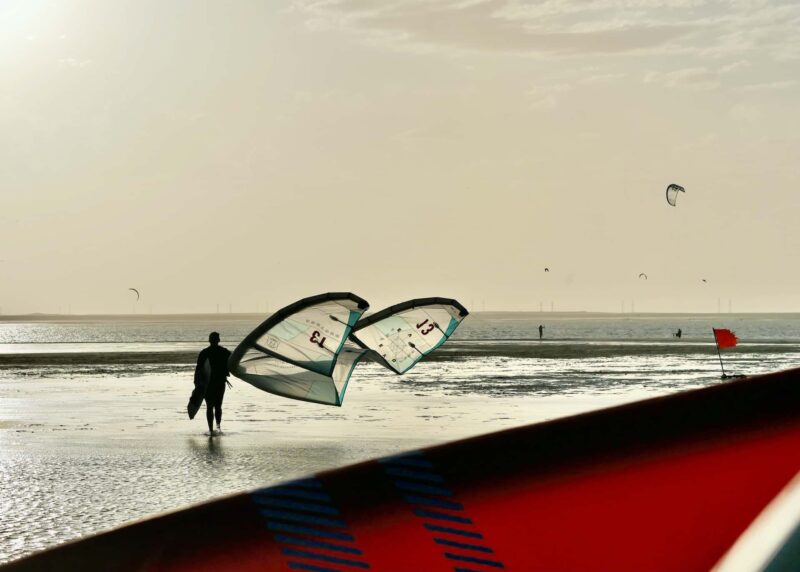‘I need to do something about this’, I thought to myself, stranded on the beach for the third day in a row while my mates were cruising gracefully across the glimmering blue water. It was another instalment of Feelgood Camp and I was spending the last week of July in the South of Sweden. Light wind is often on the menu here, but all I had available was my 10m Switchblade – and it wasn’t enough most of the days during my stay. Kind as they are, Bjorn and Jonas would come in and lend me their kites every so often. A 12 and 14 meter Switch Nitro respectively. ‘Next year I’m bringing a light wind kite!’
And it wasn’t just for Feelgood Camp. The UK summer also sees many sub 15 knots days, where nowadays you mainly see foilers out. It doesn’t have to be that way though, unless you’re keen to take up hydrofoiling and open up the door to the really light wind days. With a good light wind kite you can go out on a twin tip in as little as 10 knots, at 12 you might even catch some air.
So which kite is best for light wind kiting if you want to stick with your twin tip rather than going surf board or foil? Before we dive into it, let’s go through some other factors to bear in mind when the forecast is looking blue and turquoise.
Tips for light wind kiting

Technique
Light wind kiting is an art. If storm kiting is like going to a rave, light wind kiting is the gentlest of ballroom dancing. You have to be proactive in your moves as you’re dealing with larger kites, and remember that the power is found when you pick up board speed and sheet out, not in. If you need to relaunch in light wind you’ll need yet another skill set. Trying to make a stubborn child eat its veggies springs to mind – it’s a finely tuned negotiation process.
Board type
Hydrofoil boards get you out in barely nothing, surf boards have good float and will get you out early as well. If you’re a die-hard twin tip rider like myself you can maximise the light wind ability by riding a low rocker, extra wide board. The length matters less, but widths of 42cm+ will be useful in light winds. Big, flat boards are horrible for jumping however, and not much fun to ride either, so as always it’s a trade off you have to take into consideration.

Spot condition
Finally, and this might go without saying, but the more calm and flat the water is, the less wind you need to power through. Chop slows you down, and waves can really mess with your speed. If there is a current it will either slow you down or speed you up. In tide dependant spots, low tide tends to bring more calm and flat conditions.

Which is the best kite for light wind kitesurfing?
Kites come in two categories: The one that you pump up to make rigid, known as LEI kites (Leading Edge Inflatable) and the one where air is caught in pockets thus making the kite rigid, known as foil kites. Foil kites are traditionally unbeatable in terms of light wind performance thanks to their light weight and efficient power transfer. But light wind LEI kites have come a long way in recent years and can now give foil kites a real run for their money.
LEI versus Foil kites
I’ve always flown LEI kites, the common choice for kitesurfers. They float, are easy to relaunch and are versatile. For my light wind kite research I took a serious look at foil kites. They definitely make a strong case: They’re light, pack down really small and don’t require a pump, making them perfect for travel. You can roughly expect the same power transfer as a LEI kite two sqm larger and their super high aspect, flat shape results in super floaty jumps.
On the flip side they are trickier to launch and land without assistance, have long bridles that can tangle and stretch and need regular calibration, and can be tricker to relaunch if they catch water. They are also a bit more expensive than LEI kites, although new LEIs are now up there as well, and foil kites tend to hold their resell value better.
So, there are both pros and cons with either kite type. LEI kites are easy and can provide good performance. Foil kites are a bit more work to fly and maintain but will get you out on the water earlier and offer great hang time and floaty jumps.
Which kite did I get?
The most popular freeride foil kite seems to be the Flysurfer Soul. No one ever says anything bad about it. It’s expensive but after speaking to people who use it and reading various reviews and forum posts online it seemed like money well invested for those light wind days. It comes in many sizes, but for my needs the 12 or 15 sqm made sense.
I also got my hands on two demo kites from Airwave; the Koala 10m, a freeride foil kite and the Alma 6m, a single skin hybrid kite. I flew these on the beach and also tried the Koala on the water. I wish I could’ve demoed larger sizes but at least it gave me a feeling for what foil kites are about.


Trying the Airwave kites
Both kites were super stable in the air, and once powered up behaved not too differently from LEI kites, meaning if you have experience with inflatable kites, the step to handle foil kites shouldn’t be too far. My biggest concern was the launch and landings with no assistance. If you have someone to help you it’s easy enough, but without the help I found both launching and landing a bit sketchy. Admittedly I’m a complete newbie with these type of kites and as you gain experience you also gain confidence and skills. But since I do ride alone from time to time and my local beach isn’t particularly large or absent of obstacles, I do need these crucial steps to be as simple as possible. With my LEIs I launch and land using a tether and that’s pretty much as reliable as they come.
Reconsidering LEI
A car park chat with Stav, a local instructor in the region and avid water man for decades, confirmed my suspicion as to why we don’e see more foil kites around here. It’s simply too much hassle. People want simple, and LEIs are simple. I pondered whereas maybe no strut or single strut was the perfect best-of both-worlds solution, but he pointed me towards the 3-strutted Duotone Juice, this being his personal choice when teaching students in light wind. I’d never heard of Juice before. Could a 3-strut really compete with foil kites and 1-strut kites?

The Juice has been around for some time and reviews online did say very good things about it. This is what I went with in the end, and I’ve got to say I’m very impressed with both light wind performance, overall handing and of curse fun factor! This kite does not compromise on jump performance, which was what I originally was looking for: The perfect light wind kite for twin tip riders that still want to go out there and jump, maybe even pull some freestyle moves.
To summarise my light wind kite research
What I’ve learnt in this process is that there is no silver bullet for light wind kiting. You will have to compromise on something, but the more firm you are on what you’re looking for, the easier it will be to decide on which kite you need.
- Foil kites will get you on the water sooner than anything else, but they can be tricky to launch, land and maintain.
- No-strut or 1-strut LEIs are light and reliable. Great for foiling and cruising but not much else, and their high end isn’t great.
- 3-strut light wind kites like the Juice or Contra performs like normal LEI kites but are a bit heavier and you might need to go up in kite size to squeeze out the lightest wind days out of them.
- Larger kites will get you going sooner, but anything above 13 sqm can feel very sluggish, take up a lot of space and quickly gets unwieldy and hard to manage if the wind picks up.
